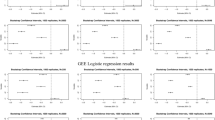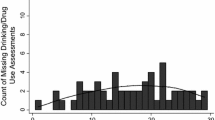Abstract
The reliability of self-reported sexual behavior is a question of utmost importance to human immunodeficiency virus (HIV) prevention research. The Timeline Follow-Back (TLFB) interview, which was developed to assess alcohol consumption on the event level, incorporates recall-enhancing techniques that result in reliable information. In this study, the TLFB interview was adapted to assess HIV-related sexual behaviors and their antecedents, and its reliability was assessed. The interview was administered to 110 participants (46% women, M age=19.7; range=18–41), and 58 participants who reported sexual behavior during the previous three months returned one week later for a second interview. Test-retest intraclass correlations (ρ) from the TLFB protocol showed that all sexual behaviors were reported reliably (ρ range=.86 to .97, median=.96). Bootstrapping, a nonparametric statistical technique, was used for significance testing in the reliability analyses. Reliability was equivalent across each of the three months assessed with the TLFB and was equivalent to conventional assessment methods (i. e. single-item questions). These findings show that the TLFB sexual behavior interview provides reliable reports of sexual behavior over three months and yields event-level data that are extremely valuable for sexual behavior and HIV-prevention research.
Similar content being viewed by others
References
Croyle RT, Loftus EF: Recollection in the kingdom of AIDS. In Ostrow DG, Kessler RC (eds),Methodological Issues in AIDS Behavioral Research. New York: Plenum, 1993, 163–180.
Catania JA, Binson D, van der Straten A, Stone V: Methodological research on sexual behavior in the AIDS era.Annual Review of Sex Research. 1995,4:77–125.
Catania JA, Gibson DR, Chitwood DD, Coates TJ: Methodological problems in AIDS behavioral research: Influences on measurement error and participation bias in studies of sexual behavior.Psychological Bulletin. 1990,108:339–362.
Sobell LC, Maisto SA, Sobell MB, Cooper AM: Reliability of alcohol abusers’ self-reports of drinking behavior.Behaviour Research and Therapy. 1979,17:157–160.
Sobell LC, Sobell MB: Timeline follow-back: A technique for assessing self-reported alcohol consumption. In Litten RZ, Allen J (eds),Measuring Alcohol Consumption: Psychosocial and Biological Methods. Totowa, NJ: Humana Press, 1992, 41–72.
Sobell LC, Sobell MB:Timeline Followback User’s Guide. Toronto, Canada: Alcohol Research Foundation, 1997.
Maisto SA, Sobell MB, Cooper AM, Sobell LC: Test-retest reliability of retrospective self-reports in three populations of alcohol abusers.Journal of Behavioral Assessment. 1979,1:315–326.
Connors GJ, Watson DW, Maisto SA: Influence of subject and interviewer characteristics on the reliability of young adults’ self-reports of drinking.Journal of Psychopathology and Behavioral Assessment. 1985,7:365–374.
Carey KB: Reliability and validity of the timeline follow-back interview among psychiatric outpatients: A preliminary report.Psychology of Addictive Behaviors. 1997,11:26–33.
Sobell LC, Sobell MB, Leo GI: Reliability of the alcohol timeline followback when administered by telephone and by computer. Twenty-Ninth Annual Convention of the Association for the Advancement of Behavior Therapy. Washington, DC: November 1995.
Ehrman RN, Robbins SJ: Reliability and validity of six-month timeline reports of cocaine and heroin use in a methadone population.Journal of Consulting and Clinical Psychology. 1994,62:843–850.
Siegel K, Mesagno FP, Chen JY, Christ G: Factors distinguishing homosexual males practicing risky and safer men.Social Science and Medicine. 1989,28:561–569.
Valdiserri RO, Lyter D, Leviton LC, et al: Variables influencing condom use in a cohort of gay and bisexual men.American Journal of Public Health. 1988,78:801–805.
Crosby GM, Stall RD, Paul JP, Barrett DC, Midanik LT: Condom use among gay/bisexual male substance abusers using the timeline follow-back method.Addictive Behaviors. 1996,21:249–257.
Kalichman SC, Carey MP, Johnson BT: Prevention of sexually transmitted HIV infection: A meta-analytic review of the behavioral outcome literature.Annals of Behavioral Medicine. 1996,18:4–13.
Gayle HD, Keeling RP, Garcia-Tunon M, et al: Prevalence of HIV infection among college and university students.New England Journal of Medicine. 1990,323:1538–1541.
Carey MP: Assessing and reducing risk of infection with the human immunodeficiency virus (HIV). In Koocher GP, Norcross JC, Hills SS (eds),Psychologist’s Desk Reference. New York: Oxford University Press (in press, 1998).
Wincze JP, Carey MP:Sexual Dysfunction: A Guide for Assessment and Treatment. New York: Guilford, 1991.
Kelly JA:Changing HIV Risk Behavior: Practical Strategies. New York: Guilford, 1995.
Carey MP, Carey KB, Weinhardt LS, Gordon CM: Behavioral risk for HIV infection among adults with a severe and persistent mental illness: Patterns and psychological antecedents.Community Mental Health Journal. 1997,33:133–142.
Carey MP, Maisto SA, Kalichman SC, et al: Motivational enhancement, behavioral skills training, and education to reduce risk of HIV infection in urban women.Journal of Consulting and Clinical Psychology. 1997,65:531–541.
Kalichman SC, Sikkema K, Kelly JA, Bulto M: Use of a brief behavioral skills intervention to prevent HIV infection among chronic mentally ill adults.Psychiatric Services. 1995,46:275–280.
Kelly JA, Murphy DA, Washington CD, et al: The effects of HIV/AIDS intervention groups for high-risk women in urban clinics.American Journal of Public Health. 1994,84:1918–1922.
Bruning JL, Kintz BL:Computational Handbook of Statistics (2nd Ed.). Glenview, IL: Scott, Foresman, 1977.
Efron B, Tibshirani RJ:An Introduction to the Bootstrap. New York: Chapman & Hall, 1993.
StataCorp:Stata Statistical Software: Release 5.0. College Station, TX: Stata Corporation, 1996.
Lunneborg CE: Estimating the correlation coefficient: The bootstrap approach.Psychological Bulletin. 1985,98:209–215.
Nunnally JC, Bernstein IH:Psychometric Theory (3rd Ed.). New York: McGraw-Hill, 1994.
Kauth MR, St. Lawrence JS, Kelly JA: Reliability of retrospective assessments of sexual HIV risk behavior: A comparison of biweekly, three-month, and twelve-month self-reportsAIDS Education and Prevention. 1991,3:207–214.
Dowling-Guyer S, Johnson ME, Fisher DC, et al: Reliability of drug users’ self-reported HIV risk behaviors and validity of self-reported drug use.Assessment. 1994,1:383–392.
McKinnon K, Cournos F, Meyer-Bahlburg HFL, et al: Reliability of sexual risk behavior interviews with psychiatric patients.American Journal of Psychiatry. 1993,150:972–974.
Needle R, Fisher DG, Weatherbee N, et al: Reliability of self-reported HIV risk behaviors of drug users.Psychology of Addictive Behaviors. 1995,9:242–250.
Temple MT, Leigh BC: Alcohol consumption and unsafe sexual behavior in discrete events.Journal of Sex Research. 1992,29:207–219.
Carey MP, Carey KB, Kalichman SC: Risk for human immunodeficiency virus (HIV) infection among persons with severe mental illness.Clinical Psychology Review. 1997,17:271–291.
Fisher JD, Fisher WA: Changing AIDS risk behavior.Psychological Bulletin. 1992,111:455–474.
DeLamater J, MacCorquodale P: The effects of interview schedule variations on reported sexual behavior.Sociological Methods Research. 1975,4:215–236.
Author information
Authors and Affiliations
Additional information
Preparation of this manuscript was supported in part by grants from the National Institute of Mental Health to Lance S. Weinhardt (MH11125) and Michael P. Carey (MH01101 and MH54929), National Institute on Alcohol Abuse and Alcoholism to Stephen A. Maisto (AA10291) and National Institute on Drug Abuse to Kate B. Carey (DA07635).
The authors thank John R. Gleason and Andrew D. Forsyth for statistical consultation and Christopher M. Gordon for comments on an earlier draft of this paper.
About this article
Cite this article
Weinhardt, L.S., Carey, M.P., Maisto, S.A. et al. Reliability of the Timeline Follow-Back sexual behavior interview. ann. behav. med. 20, 25–30 (1998). https://doi.org/10.1007/BF02893805
Issue Date:
DOI: https://doi.org/10.1007/BF02893805




